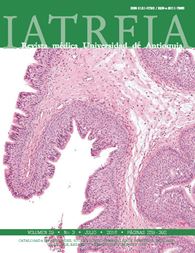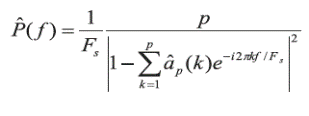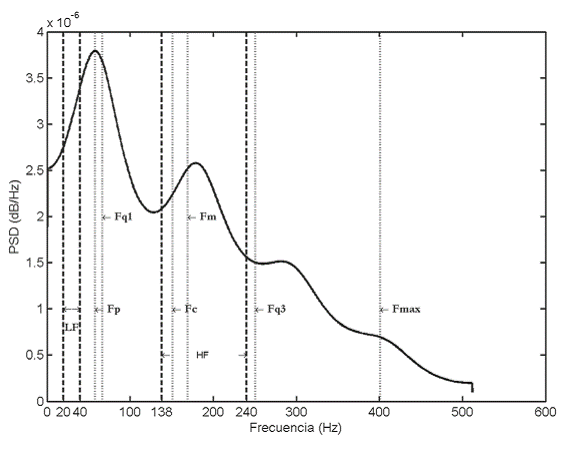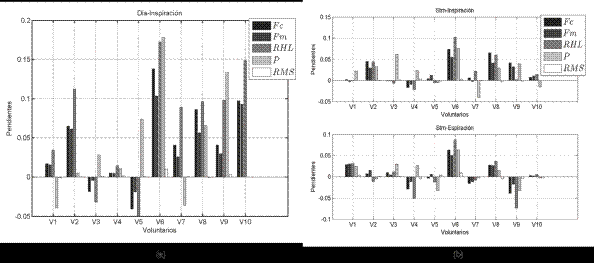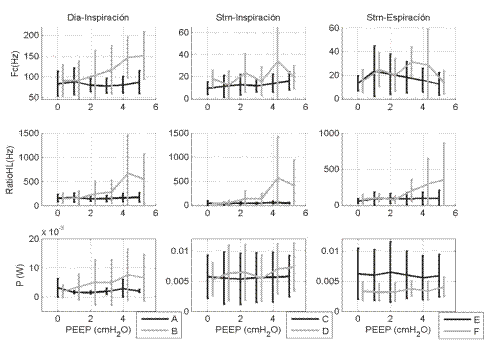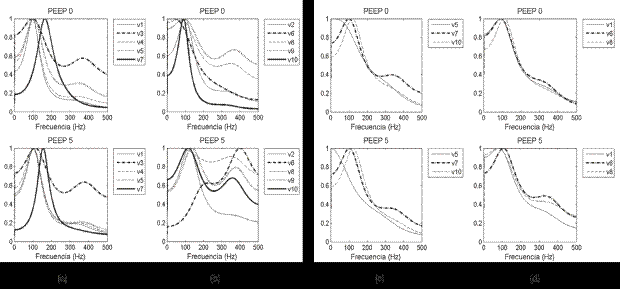Effect of PEEP increase on respiratory muscle activity assessed through surface electromyography in healthy subjects during spontaneous breathing
DOI:
https://doi.org/10.17533/udea.iatreia.v29n3a03Keywords:
biomedical signals processing, electromyography, electronic medical records, mechanical ventilation, PEEPAbstract
Introduction: In a mechanically ventilated patient with increased airway resistance, the expiratory time span is insufficient to exhale all the inspired volume. In order to maintain oxygenation and to reduce the workload of respiratory muscles, it is common to apply an extrinsic positive end-expiratory pressure (PEEP) that reduces tissue collapsibility, counterbalancing the increased resistance. Several studies have shown the usefulness of surface electromyography (sEMG) to quantify the work of breathing (WOB), particularly in patients with obstructive diseases.
Objective: To assess the effect of incremental PEEP in the respiratory muscle activity through sEMG in healthy volunteers noninvasively ventilated.
Methods: Study of muscle activity in 10 healthy male volunteers, noninvasively ventilated for 20 minutes. The extrinsic PEEP was applied from 0 to 5 cm H2O in steps of 1 cm H2O at 30 seconds intervals.
Results: The bio-potentials of diaphragm and sternocleidomastoid muscles revealed different breathing patterns in response to incremental PEEP: 1) increase in the workload of both muscles during inspiration and expiration; 2) increase in the workload of only one muscle; 3) a remarkable increase in muscle activity only in expiration.
Conclusion: In noninvasively ventilated volunteers, sEMG quantitatively relates the PEEP level with changes in sternocleidomastoid and diaphragm activity.
Downloads
References
(1.) Esteban A, Frutos F, Tobin MJ, Alía I, Solsona JF, Valverdu V, et al. A comparision of four methods of weaning patients from mechanical ventilation. N Engl J Med. 1995 Feb;332(6):2-7. DOI 10.1056/NEJM199502093320601.
(2.) Osorio Bonilla JA, Franco Granillo J, Martínez Sánchez J, Elizalde González JJ. Trabajo respiratorio según el grado de sensibilidad de disparo por flujo en pacientes con ventilación en soporte por presión. Rev Asoc Mex Med Crit y Ter Int. 1998 May-Jun;12(3):95-101.
(3.) Monge García MI, Gil Cano A, Gracia Romero M, Díaz Monrové JC. Cambios respiratorios y hemodinámicos durante una maniobra de reclutamiento pulmonar mediante incrementos y decrementos progresivos de PEEP. Med Intensiva. 2012 Mar;36(2):77-88. DOI 10.1016/j.medin.2011.08.008.
(4.) Acosta P, Santisbon E, Varon J. The use of positive end-expiratory pressure in mechanical ventilation. Crit Care Clin. 2007 Apr;23(2):251-61.
(5.) Ortiz G, Dueñas C, Lara A, Garay M. La carga de la musculatura respiratoria y el trabajo respiratorio. AMCI. 2012 Jun;12 Supl 2:21-41.
(6.) Artacho R, García de La Cruz JI, Panadero JA, Jurado Solís A, Degayón H, Guerrero A. Ventilación mecánica no invasiva. Utilidad clínica en urgencias y emergencias. Emergencias. 2000;12:328-36.
(7.) Chatburn R, Kacmarek R, Chipman D, Malhotra A. Physical basis of mechanical ventilation. In: Tobin MJ, editor. Principles & Practice of Mechanical Ventilation. 2a ed. Estados Unidos: McGraw-Hill; 2006. p. 37-129.
(8.) Zory R, Molinari F, Knaflitz M, Schena F, Rouard A. Muscle fatigue during cross country sprint assessed by activation patterns and electromyographic signals time-frequency analysis. Scand J Med Sci Sports. 2011 Dec;21(6):783-90. DOI 10.1111/j.1600-0838.2010.01124.x.
(9.) Maarsingh EJ, van Eykern LA, Sprikkelman AB, Hoekstra MO, van Aalderen WM. Respiratory muscle activity measured with a noninvasive EMG technique: technical aspects and reproducibility. J Appl Physiol (1985). 2000 Jun;88(6):1955-61.
(10.) Gandevia SC, McKenzie DK, Plassman BL. Activation of human respiratory muscles during different voluntary manoeuvres. J Physiol. 1990 Sep;428:387-403.
(11.) Mañanas MA, Fiz JA, Morera J, Caminal P. Analyzing dynamic EMG and VMG signals of respiratory muscles. IEEE Eng Med Biol Mag. 2001 Nov-Dec;20(6):125-32.
(12.) Alonso JF, Mañanas MA, Hoyer D, Topor ZL, Bruce EN. Evaluation of respiratory muscles activity by means of cross mutual information function at different levels of ventilatory effort. IEEE Trans Biomed Eng. 2007 Sep;54(9):1573-82.
(13.) Bruce EN, Goldman MD. High-frequency oscillations in human respiratory electromyograms during voluntary breathing. Brain Res. 1983 Jun;269(2):259-65.
(14.) Hodges PW, Gandevia SC. Pitfalls of intramuscular electromyographic recordings from the human costal diaphragm. Clin Neurophysiol. 2000 Aug;111(8):1420-4.
(15.) Camacho A, Hernández AM, Londoño Z, Serna LY, Mañanas MA. A synchronization system for the analysis of biomedical signals recorded with different devices from mechanically ventilated patients. Conf Proc IEEE Eng Med Biol Soc. 2012;2012:1944-7. DOI 10.1109/EMBC.2012.6346335.
(16.) De Luca CJ, Gilmore LD, Kuznetsov M, Roy SH. Filtering the surface EMG signal: Movement artifact and baseline noise contamination. J Biomech. 2010 May;43(8):1573-9. DOI 10.1016/j.jbiomech.2010.01.027.
(17.) Merletti R, Farina D, Disselhorst-Klug C. Single-Channel Techniques for Information Extraction from the Surface EMG Signal. In: Parker PA, Merletti R, editors. Electromyography: Physiology, Engineering, and Non-Invasive Applications. New Jersey: IEEE PRESS; 2004. p. 169-204.
(18.) Gao Z, Wu J, Zhou J, Jiang W, Feng L. Design of ECG Signal Acquisition and Processing System. In: International Conference on Biomedical Engineering and Biotechnology; Macau, China 2012. IEEE: Macau; 2012. p. 762–4. DOI 10.1109/iCBEB.2012.128.
(19.) Lu G, Brittain JS, Holland P, Yianni J, Green AL, Stein JF, et al. Removing ECG noise from surface EMG signals using adaptive filtering. Neurosci Lett. 2009 Oct;462(1):14-9. DOI 10.1016/j.neulet.2009.06.063.
(20.) Haykin S. Least-Mean-Square Algorithm. In: Adaptive filter theory. 5th ed. New Jersey: Pearson Education; 2014. p. 365-439.
(21.) Proakis JG, Manolakis DG. Filtros Adaptativos. En: Tratamiento Digital de Señales. 4a ed. Madrid: Pearson Pretince Hall; 2007. p. 785-850.
(22.) Gross D, Grassino A, Ross WR, Macklem PT. Electromyogram pattern of diaphragmatic fatigue. J Appl Physiol. 1979 Jan;46(1):1-7.
Published
How to Cite
Issue
Section
License
Copyright (c) 2016 Iatreia

This work is licensed under a Creative Commons Attribution-ShareAlike 4.0 International License.
Papers published in the journal are available for use under the Creative Commons license, specifically Attribution-NonCommercial-ShareAlike 4.0 International.
The papers must be unpublished and sent exclusively to the Journal Iatreia; the author uploading the contribution is required to submit two fully completed formats: article submission and authorship responsibility.


